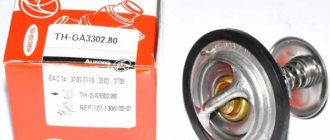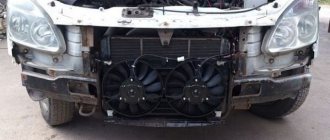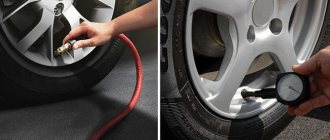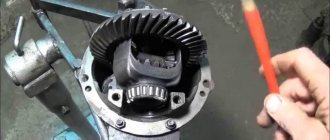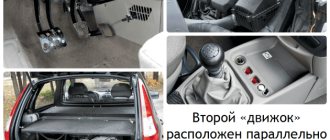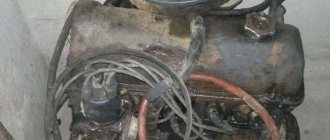When a car's heating system fails, a common cause of problems is a faulty heater core. Therefore, there is an urgent need to replace this element on your car. The procedure for changing the stove element itself may differ depending on the design features of the car. But the key issue here is the right choice. The main dispute is over aluminum and copper products. It is not always possible to give a definite answer to which radiator is better - aluminum or copper. To do this, you need to study their features, strengths and weaknesses. This will allow you to give an objective assessment of the devices and understand whether there is an obvious leader among them.
Recommendations for choosing a radiator.
How it works
First you need to understand how the heater cores in your car function. The heat inside the cabin comes from the running engine. This is a kind of side effect of the operation of the power unit. It generates heat, which engineers have learned to use for the benefit of humans, that is, to heat the interior of the car with it. The heat itself is created as a result of the combustion of the air-fuel mixture and friction between the surfaces of engine elements. To remove this heat from the heated components of the motor, its design includes a cooling system. One of its functions is to heat the car interior.
A logical conclusion follows from this. The hotter the engine is, the warmer it can be inside the cabin. The coolant becomes hot, removing heat from the engine, and passes into the heater core. Here the fan comes into operation, blowing air through the heated radiator and distributing it throughout the car. To be more precise, around the cabin. The driver and passengers can regulate the temperature of the supplied hot air using deflectors and a tap, which are located on the line between the power unit of the car and the stove itself. This is the simplest shut-off type valve, which has a mechanical or electrical drive type. With its help, the amount of cooling liquid passing through the heating system is regulated.
If you raise the temperature on the control unit, the tap will open more. When the temperature decreases, the opposite effect occurs. Its functionality directly affects the operation of the machine's stove. If the system cannot provide full passage for the coolant heated by the engine, then the driver and passengers will feel cold. The temperature outside plays a big role. In the case of a serviceable and well-functioning heater, even it will not be able to warm up the interior as much as possible if the outside temperature is at a very low level. The colder it is outside, the more difficult it is for the stove to warm up the interior.
Radiator design
It is important to consider that the car has two radiators at once. One of them is included in the heating system and is in many ways similar to its older brother installed in the cooling system. Their functions are also similar. Only the cooling radiator mainly transfers the selected heat to the atmosphere, and the small one (heating radiator) is intended for the interior. Both devices provide for the presence of 2 tanks connected by tubes to each other. The plates necessary to increase the cooled area are mounted to them. The more plates the device has, the higher its heat transfer rate will be.
Therefore, when choosing a new heating radiator, you should definitely pay attention to the number of plates present. If their density is high, then the heat transfer will be at a high level. The main difference between them is the material of manufacture. The choice in favor of a copper or aluminum option is not so clear-cut. You should study in detail the characteristics and features of the two options in order to understand which one would be better to choose in each specific case.
Advantages and disadvantages of copper radiators
Copper radiators are one of the best heating devices due to the following advantages:
- High heat transfer coefficient and efficiency. According to the latter indicator, these devices are almost 5 times superior to their cast iron counterparts.
- The good mechanical properties of the material determine the strength of copper radiators.
- High temperature resistance. Possibility of use in systems with high operating temperatures (up to 150 degrees Celsius).
- Resistance to microorganisms due to the antiseptic properties of copper.
- Lack of chemical interaction with almost any type of coolant (for example, the use of antifreeze is acceptable).
- Long service life.
Disadvantages of copper appliances:
- High cost relative to prices for other types of radiators.
- Combination with pipes made of other metals is unacceptable.
- Reduced service life in the presence of abrasive impurities in the working substance.
Advantages and disadvantages of copper devices
Let's start with copper. Many people call them the preferred choice because they have better technical characteristics. But there are also disadvantages here. Let's start with the advantages. These include:
- Thermal conductivity. This is one of the main arguments that speaks in favor of copper and against aluminum. Copper devices are characterized by greater thermal conductivity compared to competitors. As you already understood from the above, the higher the radiator’s thermal conductivity, the higher the quality of its work in heating the interior.
- Suitability for repair. Copper is a rather unique material. It is both lightweight and yet resists damage from minor impacts and dents. Therefore, it is much easier to repair in case of emergency situations. The experience of car owners clearly shows that in case of cracks or damage to the tubes, you can easily solder them with your own hands or seek help from specialists. With such a repair, the thermal conductivity does not change, and therefore partial failure does not force you to throw away the radiator and buy a new one in its place.
- Copper tank. Copper radiators are equipped with tanks made of similar material. This is considered a significant advantage, since such design features help improve the performance characteristics of the product.
Pros and cons of aluminum radiators
By comparing the strengths and weaknesses of devices, you can understand their main differences. After all, the difference between copper and aluminum radiators lies in their main characteristics. What is considered an objective advantage for one person turns out to be a serious disadvantage for another. Just look at the pros and cons of aluminum products and you will understand the difference between them.
Let's start with the positive aspects of aluminum as a material for the manufacture of car heater radiators.
- Price. While cost was considered a disadvantage of copper radiators, here it is a serious advantage. If we compare the price tags for both products, aluminum ones will win by about 2 times. Much depends on the manufacturer, but still the difference in cost remains significant. The buyer can save a lot. Because of this, aluminum units have such a large audience.
- Heat dissipation. Provided that the number of plates is increased, that is, the cooling area becomes larger, aluminum will not be much inferior to copper in terms of heat transfer. Therefore, in this component they are practically the same. But remember that aluminum ones are cheaper.
- Range. A huge proportion of modern cars that have been produced over the past few years are equipped with aluminum units from the factory. Because of this, the number of their analogues and original spare parts offered by different manufacturers is growing. The copper versions have a more modest choice.
We're done with the benefits. Let's move on to the other side of the coin. Aluminum is not doing so well. The stated advantages are beyond doubt. But still, motorists make a choice in favor of copper after they have studied the main disadvantages of the design option under consideration.
Therefore, the disadvantages should definitely be pointed out. This clearly shows the differences between the elements. The main disadvantages include:
- Thermal conductivity indicators. This is a very important drawback that literally negates all the objective positive qualities of the devices. If the driver needs to get the most efficient radiator so that the heating system works efficiently and fully warms up the interior, he will not look in the direction of aluminum.
- Repairability
Approximately the same conclusions can be drawn regarding these devices, which are made from two different materials.
Comparison with other types of radiators
A potential buyer is always interested: which radiators are better: aluminum, copper or something else? It is impossible to answer unequivocally, since each type is designed for specific operating conditions. We will try to name the leaders based on their most important performance characteristics.
Thermal power
The best performance is for copper and aluminum, slightly lower for bimetal. They deliver up to 200 W. This figure is slightly lower for cast iron and steel. Overall, any of these devices will be good. The only caveat is inertia. It is maximum for cast iron, so it takes a very long time to heat up. But it also releases the accumulated heat slowly. Therefore, the operation of such devices is difficult to regulate.
Liquid temperature
In systems where sudden changes in the temperature of the transported liquid are possible, it is important that the metal can withstand them without compromising its characteristics. Copper and cast iron do this best. If, based on this indicator, we compare which radiators are better, steel or aluminum, then it turns out that the former lose. It is better not to install them where the liquid can heat up to 110C.
Operating pressure
An important characteristic that determines the scope of application of the equipment. The bimetal withstands the most, from 16 to 36 bar. It can be used in any systems. Copper is not far behind it with its 16 bar. Steel batteries can carry a slightly smaller load. This is 10-12 bar. Aluminum “holds” from 6 to 25 bar. It all depends on the manufacturer and model.
Coolant type
In a centralized system, only water can be used, while in autonomous systems other liquids are also used. This is possible for cast iron, copper and steel. It is not advisable to use aluminum devices in such cases, although there are mixtures specifically for such batteries.
When choosing a radiator, it is important to decide on the type of connection. It can be bottom or top
—> Sources used:
- https://remam.ru/vozdsys/kakoj-radiator-pechki-luchshe-mednyj-alyuminievyj.html
- https://tehnopanorama.ru/avto/medniy-ili-alyuminieviy-radiator-pechki-dlya-avto.html
- https://provaz07.ru/salon-i-kuzov/kakoj-radiator-pechku-vaz-2107.html
- https://www.ivd.ru/stroitelstvo-i-remont/otoplenie/kakoj-radiator-luchshe-alyuminievyj-ili-mednyj-36531
Where to choose
The question of choice still remains open. But you need to try to answer it as objectively as possible. Despite the shortcomings mentioned, when choosing a radiator several years ago, everyone would definitely have opted for a copper product. Such designs were objectively better and could ensure excellent performance of the entire heating system of the car. But now the situation is different. There are many manufacturers, but there are no truly high-quality copper elements as they used to be. This is due to the desire to reduce the cost of production.
As a result, all sorts of impurities began to be added to copper, which negatively affect strength, quality, thermal conductivity and other aspects that have always been considered the main advantages. Therefore, it is more logical to choose aluminum. This material does not need to be reduced in price due to impurities, therefore it actually completely retains its advantages. And car owners say the disadvantages are not so significant, since the radiator is still a consumable item that can be changed every few years.
Under current conditions, aluminum is objectively better than copper. But if you manage to find the highest quality product without any admixtures of other metals, then you can safely opt for a copper stove radiator. But what you should categorically refuse is painted heating radiators. The presence of a layer of paint significantly reduces heat transfer. In addition, when the paint coating heats up, it begins to emit an unpleasant odor that enters the interior of the car. Try to carefully monitor the heating system to prevent clogging of the channels. If they turn out to be clogged, the fact of what material these elements of the car heating system are made of will no longer play any role.
Manufacturers
If you have been able to determine for yourself which radiator is better, then all that remains is to resolve the issue with the manufacturer. Copper and aluminum are actively used in the production of their products by various companies that create components for automotive heating systems. There are a lot of good manufacturers, but everyone has their own experience in working with certain factories. It is impossible to objectively determine the best company. Some people speak well of them, others were not particularly pleased. The question is quite subjective.
Aluminum or copper-aluminum batteries?
Of course, these types of radiators have undoubted advantages over other types of heating systems. There are cold winters in Russia, and every owner wants to insulate their home as much as possible, while saving on heating costs.
Aluminum selection criteria
Aluminum radiators are an ideal solution for heating a small room. Statistics show that the demand for batteries made of this metal is as high as possible. Low cost, lightness of design, ease of installation are the main factors when choosing radiators made of aluminum.
Aluminum batteries are suitable for installation in any room. They are not afraid of temperature changes and high degrees of coolant. Aluminum has high thermal conductivity and convection.
The shape of the device is designed to heat the air evenly. The internal volume of this system is insignificant, so a low-power pump is suitable. Despite this, it has a significant output of thermal energy.
In the markets you can find a huge variety of colors for aluminum radiators. Which is also a plus of this choice.
The only thing that may confuse the buyer is that aluminum structures are sensitive to the pH environment. If the indicator is high, the system will not last long. Does not tolerate the presence of impurities in the liquid. To avoid corrosion, the composition of the coolant should be controlled. If this is not possible, then it is better to abandon aluminum radiators.
What is thermal conductivity
This term means the ability of various materials to exchange energy , which in this case is represented by heat. In this case, energy transfer passes from the hotter part to the colder part and occurs due to:
- Molecules
- Atoms.
- Electrons and other particles of the metal structure.
The thermal conductivity of stainless steel will differ significantly from that of another metal - for example, the thermal conductivity of copper will be different than that of steel.
To indicate this indicator, a special value is used, called the thermal conductivity coefficient. It is characterized by the amount of heat that can pass through a material in a certain unit of time.
Indicators for steel
Thermal conductivity can vary significantly depending on the chemical composition of the metal. The coefficient of this value will be different for steel and copper. In addition, with an increase or decrease in carbon concentration, the indicator under consideration also changes.
There are other features of thermal conductivity:
- For steel that does not have impurities, the value is 70 W/(m* K).
- Carbon and high-alloy steels have much lower conductivity. Due to an increase in the concentration of impurities, it is significantly reduced.
- The thermal effect itself can also affect the structure of the metal. As a rule, after heating, the structure changes its conductivity value, which is associated with a change in the crystal lattice.
The thermal conductivity coefficient of aluminum is much higher, which is due to the lower density of this material. The thermal conductivity of brass also differs from that of steel.
From copper to aluminum
The first truly efficient heat exchangers for cooling systems were made of copper. This metal has the best thermal conductivity of all structural materials, and for some time it seemed to experts that copper had settled in radiators forever. About forty years ago, copper-brass radiators (copper core and brass tanks) seemed to be the height of technical progress. The individual elements of the radiators were connected by soldering - copper alloys are easily soldered. And, despite the obvious disadvantages of copper heat exchangers - their very low mechanical strength and rigidity, as well as the high energy consumption of manufacturing - few automakers saw an alternative to this “red” metal.
Only in the 80s of the last century (historically quite recently) did copper have a competitor - aluminum. This metal was inferior to copper in heat transfer. But it is stronger than copper and more rigid, which allows, with the help of design tricks (aluminum allows you to make the flat-oval radiator tube wider and place these tubes closer to each other), to make radiators with the same efficiency as copper-brass, and even higher. Despite the obvious advantage in the price of raw materials, until the 80s they could not make aluminum radiators. The design of copper-brass radiators was so firmly established in the minds of developers that the technology for the production of aluminum radiators began to develop along the track laid by copper heat exchangers. Aluminum began to be soldered. And, if copper alloys are easily soldered, then problems arose with aluminum - it instantly oxidized, and soldering became impossible. Aluminum radiators became a reality only when the problem of soldering aluminum on an industrial scale was solved. Special solders and furnaces (both cyclic and continuous) have appeared that make it possible to reliably connect structural elements into a single heat exchanger using soldered seams. This is how aluminum-brazed radiators appeared.
The design of radiators has been stabilized - an aluminum core and plastic tanks for passenger cars, and an aluminum core and aluminum tanks welded to it in an inert gas environment (all-aluminum radiators - they are more durable) for trucks and special equipment.
Copper has finally and forever (probably forever) lost in the competition to aluminum-brazed radiators. Copper-brass radiators are no longer used at all in new technology. Their production represents a small fraction of a percent of the total volume of automotive heat exchangers and is aimed at the market for spare parts for older vehicles.
The problem of complexity, capriciousness and high cost of equipment for soldering aluminum heat exchangers, of course, exists and has always existed. But enterprises that mass produce automobile heat exchangers have come to terms with this technology, distributing invoices for huge runs of products.
In the early 2000s, few people imagined that this design would quickly begin to lose ground.
More efficient, more technologically advanced, cheaper
Petr Nechiporenko, commercial director of the management company that produces automotive heat exchangers under the Luzar brand, told our readers about the developments of generations of radiators that are replacing the aluminum-brazed design.
The technological complexity of aluminum soldering forced us to look for alternative structural and technological options for radiators almost simultaneously with the development of aluminum soldering. One of these alternatives has existed for a long time - these are aluminum prefabricated radiators that do not have soldered seams.
The essence of the design is that a round tube was used. During assembly, these tubes are inserted into the holes of the heat-removing lamella plates. For assembly there must be some clearance between the tubes and plates. But for normal operation of the heat exchanger, this gap should not exist. (In aluminum-brazed radiators, this gap was filled with solder.) When assembling the core of aluminum prefabricated radiators, a special tool, a mandrel, was passed through the tubes. This is such a long rod with a head at the end. The mandrel head deforms the tubes from the inside, increasing their diameter to such an extent as to completely eliminate the air gap between the tubes and the heat-dissipating lamellas and ensure maximum heat transfer from the radiator.
Such a radiator turns out to be cheap (due to the cost of raw materials). The burnishing technology cannot be called simple, and the equipment with which it is produced is inexpensive. But mass production made it possible to “recapture” fixed assets and make money on the production of such radiators.
Aluminum prefabricated radiators with a round tube have been used since the late 80s of the last century on Volkswagen Audi Group, Renault, Peugeot-Citroen and AvtoVAZ cars. has mastered the production of such aluminum prefabricated radiators for cars of these brands at its production near St. Petersburg.
However, today the prefabricated radiator design with a round tube has ceased to satisfy the auto industry. It's all about this round tube; it has a large aerodynamic shadow into which cold air does not fall. For this reason, prefabricated radiators with a round tube have low efficiency (significantly lower than that of aluminum-brazed ones), and they were used on cars with engines less than 100 hp, where the dimensions of the heat exchangers could be painlessly increased.
It seemed that aluminum radiators with a flat-oval tube, which are soldered with special solders in a nitrogen environment, are the only progressive design capable of meeting the modern needs of the automotive industry.
It turns out not. In the early 2000s, a prefabricated radiator without a soldered seam, which had a flat oval tube rather than a round one, appeared (at first on very expensive cars).
Now this technology is used everywhere (on LADA Largus, Renault Duster, Nissan Qashqai cars, for example), and we can proudly say that it is implemented in production in Pargalovo near St. Petersburg. We produce prefabricated radiators with a flat-oval tube there.
The advantages of such radiators turned out to be colossal. The efficiency of the prefabricated radiator turned out to be 3–7% higher than that of a similar soldered one. Greater efficiency can be achieved due to exceptionally reliable contact, which ensures better heat transfer between the tubes and heat-dissipating lamellas than is achieved with soldered radiators. Due to the fact that the thermal conductivity of solder is worse than that of aluminum, in addition, gaps during soldering reduce efficiency, and it is very difficult to achieve an absolutely continuous seam between tubes and lamellas. An average saving of 5% (this is a lot for radiators) allows you to either save on material or increase the characteristics of radiators with the same dimensions.
Such radiators are already produced and have passed all homologations for AvtoVAZ vehicles (Granta, Priora, and in the future Vesta) and Chevy Niva.
Along with prefabricated radiators with a flat oval tube, our company’s specialists have found an opportunity to increase the efficiency of a prefabricated radiator with a round tube without increasing the amount of metal used. A standard radiator with a round tube (Sofico technology) has two rows of tubes located one after another (corridor version). On “Luzar” the tubes were arranged in a checkerboard pattern, shifting the second row by half a step. This design makes it possible to increase the efficiency of a prefabricated radiator with a round tube by 10% compared to the same radiator, where the tubes are arranged in a corridor order. This design is currently being implemented for Volkswagen Audi Group cars produced in Kaluga (Skoda Rapid and Polo Sedan).
We then found an opportunity to combine a flat oval tube prefabricated radiator design with the benefits of a staggered tube arrangement. Using this technology, we are able to obtain a radiator whose heat transfer characteristics are significantly higher than a similar radiator of a soldered design. In addition, radiators of our design can withstand significantly greater internal pressure. Here we can talk about the actual creation of a new product that fully satisfies the needs of automakers for the near future.
So, I developed and implemented two technologically constructive solutions: prefabricated radiators with a flat-oval tube and prefabricated radiators with staggered rows of tubes. By using these solutions together or separately, we can offer our automotive industry efficient, technologically advanced and low-cost heat exchangers of the most advanced design. Already this year, we plan to cover 80% of all cars officially supplied to Russia with our range of radiators for cooling and air conditioning systems, and to offer RADIATORS FOR ALL CARS in the very near future.
Effect of carbon concentration
The carbon concentration in steel affects the amount of heat transfer:
- Low carbon steels have a high conductivity index. That is why they are used in the manufacture of pipes, which are then used to create the heating system pipeline. The coefficient value varies from 54 to 47 W/(m* K).
- The average coefficient for common carbon steels is a value from 50 to 90 W/(m* K). That is why such material is used in the manufacture of parts for various mechanisms.
- For metals that do not contain various impurities, the coefficient is 64 W/(m* K). This value does not change significantly under thermal influence.
Thus, the considered indicator for alloyed alloys may vary depending on the operating temperature.
How many moves?
The nuances of terminology do not end there. Radiators are divided into single-pass and double-pass. With single-pass ones, the liquid passes through all the radiator tubes in one direction - from one tank to another. But with a two-way one, one tank is divided into two parts by a partition; the liquid, having entered through the upper part, moves along half of the tubes in one direction, and then, in another tank, changes the direction of movement and returns to the second part of the first tank, moving in the opposite direction.
When creating new Luzar radiators, a test bench is used to evaluate the effectiveness of the design.
When creating new Luzar radiators, a test bench is used to evaluate the effectiveness of the design.
Importance in everyday life and production
Why is it important to consider thermal conductivity? A similar value is indicated in various tables for each metal and is taken into account in the following cases:
- In the manufacture of various heat exchangers. Heat is one of the important carriers of energy. It is used to provide comfortable living conditions in residential and other premises. When creating heating radiators and boilers, it is important to ensure rapid and complete heat transfer from the coolant to the end consumer.
- In the manufacture of outlet elements. You can often encounter a situation where you need to remove heat rather than supply it. An example is the case of heat removal from the cutting edge of a tool or gear teeth. To ensure that the metal does not lose its basic performance qualities, rapid removal of thermal energy is ensured.
- When creating insulating layers. In some cases, the material should not conduct thermal energy transfer. For such operating conditions, a metal is selected that has a low heat conductivity coefficient.
Operating principle of the heater
To make the right choice, you need to know the principle of operation of the heating system in a car.
Heat enters the car interior from the engine, this is a side effect of its operation. Heat is generated as a result of fuel combustion and from rubbing surfaces. To remove heat from very hot parts, the engine is equipped with a cooling system, an integral part of which is interior heating. Therefore, the hotter the engine gets, the better the heating. Hot coolant is supplied to the heater core, and the fan, passing air through it, dissipates heat throughout the cabin.
The temperature of the air leaving the deflectors is regulated by a tap located on the line between the motor and the stove. This is a regular shut-off valve with a mechanical or electrical drive; it regulates the amount of coolant that passes through the heater (by increasing the temperature on the control unit, the valve opens more; by decreasing the temperature, it closes). How the stove will work greatly depends on its operation. If it does not work correctly (does not fully open the passage for liquid), then it will be cold in the cabin.
Also an important factor is the temperature “overboard”; even a well-functioning heater in cold weather will heat a little worse, since the liquid does not heat up enough, because of this the heating becomes insufficient. The thermostat has a big influence: if it doesn’t work correctly, then don’t install any radiator, and cold air will blow from the deflectors. First you need to check the proper functioning of the entire system as a whole, and then think about replacement.
Device
The radiator of the heating system is similar to its older brother from the cooling system. And their functions are similar, only the large one releases heat into the atmosphere, and the small one into the cabin. Both have two tanks in their design, which are connected to each other by tubes. Plates are attached to the tubes by soldering, increasing the cooling area (the more plates, the greater the heat transfer). Therefore, when choosing, you need to pay special attention to the number of plates. This can be done by placing both copies together and visually inspecting the density of the plates. Which radiator has a higher density, the heat transfer is higher. Liquid inlet and outlet pipes are attached to one of the tanks. Some models are equipped with places for attaching to a car.
Copper stove radiator
- Copper has greater thermal conductivity than aluminum. And with an increase in thermal conductivity, heating improves.
- Maintainability. Copper is soft and will not be damaged by minor dents. Even if cracks appear, burst tubes can be soldered, leaving thermal conductivity unchanged.
- The copper radiator is equipped with a tank made of the same material, which significantly improves its performance characteristics.
Flaws
This type has only one drawback - its price.
The radiator is leaking: what to take instead?
Once upon a time, the first VAZ G8s shocked almost everyone and everything. Including its radiators made... from aluminum!
“Well, we figured it out,” the experienced ones shook their heads. - The copper one soldered and moved on - but what to do with this? Should I buy a new one?
Everything has changed since then. Soft, heavy and expensive copper has completely given way to aluminum. And to look at the modern production of radiators of all kinds, you don’t need to go abroad - it’s much more convenient to visit St. Petersburg. In addition to the Bronze Horseman and the Savior on Spilled Blood, there is also one that produces more than half a million Luzar radiators per year.
Aluminum radiator
- The first and most important advantage will be its price. It is almost two times smaller than that of its copper counterpart.
- With an increased number of plates (increased cooling area), the heat transfer will be less than that of copper, but not so significantly.
- Prevalence in the new car market. Cars of recent years produced in our country are equipped with aluminum radiators.
Flaws
- The low thermal conductivity of the material is the biggest disadvantage.
- Non-repairability: if the tubes are damaged, they cannot be soldered, and the entire assembly has to be replaced. A plastic tank can be damaged by the slightest blow. Some copies may have a crack in the tank out of the box. There are “craftsmen” who change tanks, but this is unreliable, and there is a high probability of failure of the entire stove.
- Susceptibility to corrosion. Aluminum is more susceptible to corrosion, which leads to poor heat transfer and the formation of smudges and failure of the entire interior heating system.
Summarizing all of the above, we can say that both types are clogged with dirt equally, both from the inside and the outside. And while it is possible to wash the outside of the device, doing it properly inside is problematic. And if the cooling system of your engine is clean (the engine has been overhauled or a new car has been done), then it is better to choose a copper option, if this is possible for your model. Well, if the condition of the water jacket is unknown, it is better to take an aluminum one and replace it after a few seasons with the same cheap option.
Soldered radiators
| high heat transfer low cost of equipment no need for a massive rubber gasket (with a plastic tank) | complex production process (possible defects due to insufficient connection of tubes with tapes) no tube protection |
Cooling lamella plates are cut out of aluminum tape. They have “blinds” to trap air, holes for tubes and “stops” that determine the distance between the plates. |
Plastic turbulators are placed in round radiator tubes to improve heat transfer. |
Each finished radiator is tested at a pressure exceeding the working pressure. There are no leaks. |
